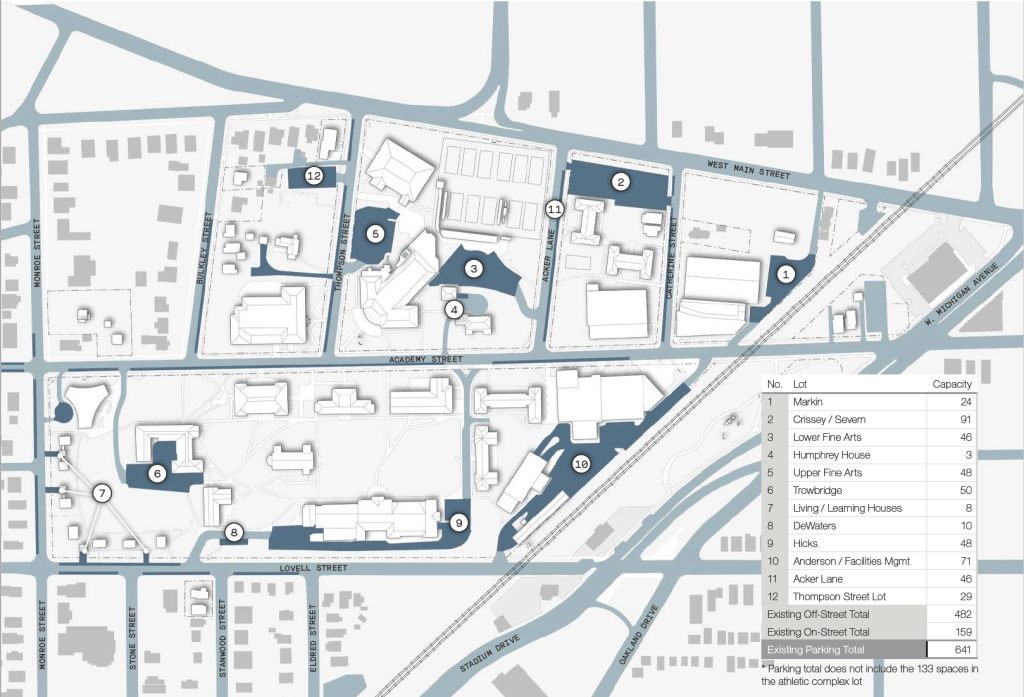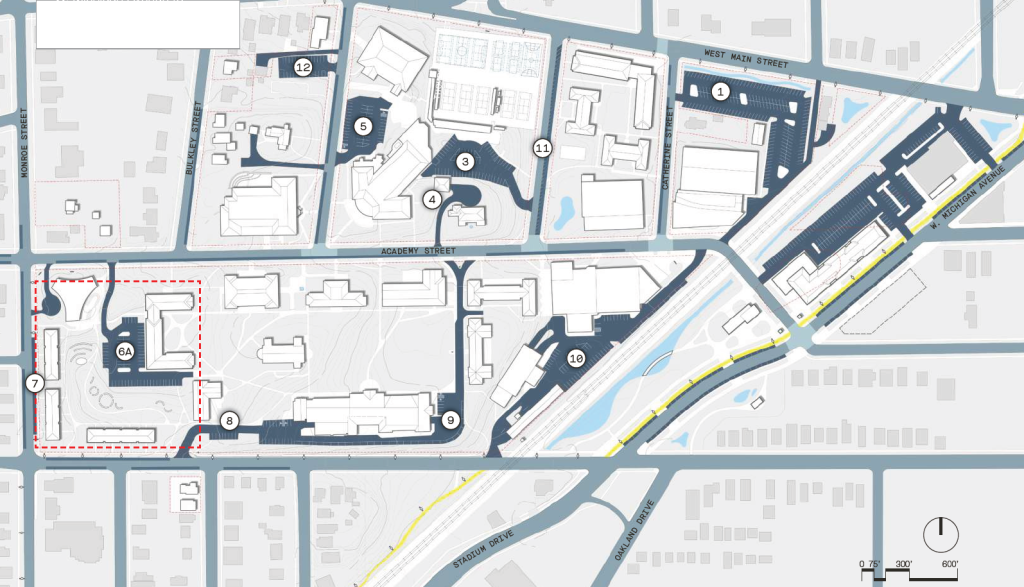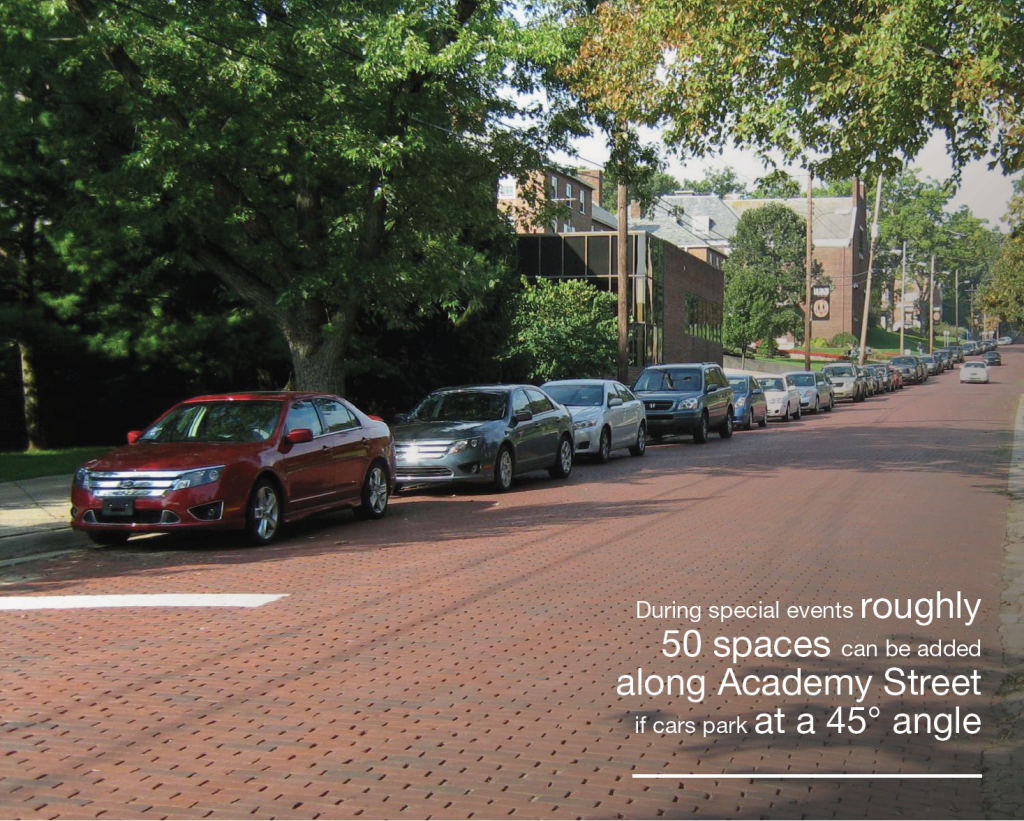A parking occupancy survey was conducted on K’s campus on Wednesday, September 21, 2011 and remains relevant. Existing parking demand was confirmed by recent internal audit. The survey documented existing occupancy levels on a typical day for off-street and on-street parking which generally reflects typical 2022 numbers. Current numbers and updated demand are shown on pages 70-71. Also included in this section are recommendations for expanding parking within K’s campus while protecting the integrity of the adjacent neighborhoods, as well as, parking management suggestions and strategies to reduce overall parking demand.
The Plan adds 96 total spaces to the K College parking supply. This will help alleviate any parking disbursement to the surrounding neighborhoods as K adds new beds to campus. An additional 265 spaces, including on and off street parking, are added with the creation of a new neighborhood node, which would likely happen beyond the 10 year timeline.
Parking Supply: 2019
The 2012 Master Plan showed a net growth of 58 spaces, increasing the buffer to demand to 8.8 % from 4.4% in 2011 (Table 10). It is acceptable practice to have the parking supply 5% to 15% over the actual parking demand.
While specific changes identified in the 2012 Campus Master Plan have not been realized, other changes have been made to increase parking. The total supply is now actually greater than what was envisioned in the 2012 report – illustrated in Figure 4.
These additions have come by adding the Thompson Street lot and reconfiguring the Trowbridge, Lower Fine Arts, and Acker Lane lots. The on-street parking remains the same.
| Group | Existing 2011 Supply | Actual 2019 Supply | Change |
|---|---|---|---|
| Off-Street | 416 | 482* | 66 |
| On-Street | 159 | 159 | 0 |
| Total – Main Campus | 575 | 641 | 66 |
| Buffer to Demand | 4.4% | 8.8% |
2022 Campus MP Parking Demand
The enrollment goals for K have remained the same, however, the College is interested in increasing the number of students living on campus (Table 11). With the addition of 258 beds, the parking demand increases to 645 spaces from the 2011 projection of 590 (Table 12).
| Cohort | Fall 2011 Quarter | 10-Year Future |
|---|---|---|
| Employees: Full Time | 350 | 361 |
| Employees: Part Time | 80 | 82 |
| Employee Subtotal | 430 | 443 |
| Contractor Employees | 12 | 12 |
| Total Faculty and Staff | 442 | 455 |
| Students: Full Time Enrollment | 1350 | 1500 |
| Students: On Campus | 850 | 1200 |
| Cohort | Ratio | Existing (2011) | 10-Year Future |
|---|---|---|---|
| Residential Students | .22 per On-Campus | 187 | 264 |
| Commuter Students | .08 per On-Campus | 68 | 76 |
| Faculty & Staff | .65 per Faculty & Staff | 287 | 296 |
| Visitors | .01 per On-Campus | 9 | 9 |
| Total Estimated Demand | 551 | 645 |

Parking & Transportation Recommendations
Proposed Parking Supply
The parking analysis performed in 2011, and confirmed by recent audits, shows that K has a peak demand of approximately 550 parking spaces during a typical weekday. It is estimated that this demand could increase to 645 spaces if the College grows to 1,500 students and with the goal that a higher percentage of students live on campus. To accommodate this increase, the Master Plan suggests strategies to increase the number
of parking spaces to 740 spaces. This is 15% over the estimated parking demand. It is acceptable practice to have the parking supply 5% to 15% over the actual parking demand. It is important to note that this increase can be accommodated within the boundaries of K’s campus, excluding the new car parking lot located at the Athletics
Complex.
Table 8 below shows the distribution of the 740 spaces on K’s campus based on the proposed Campus Master Plan. A summary of the parking modifications by lot and street is shown on Table 8. Option B and Option C show options for increasing parking within the Campus Core and Grove if needed.
| Number | Lot | Existing Capacity | Proposed Capacity | Net Change |
|---|---|---|---|---|
| 1 | Markin Lot | 24 | 183 | 159 |
| 2 | Crissey / Severn Lot | 91 | 0 | (91) |
| 3 | Lower Fine Arts Lot | 54 | 54 | 0 |
| 4 | Humphrey House Lot | 3 | 3 | 0 |
| 5 | Upper Fine Arts Lot | 48 | 48 | 0 |
| 6 | Trowbridge Lot | 50 | 70 | 20 |
| 7 | Living / Learning Houses | 8 | 14 | 6 |
| 8 | DeWaters Lot | 10 | 10 | 0 |
| 9 | Hicks Lot | 48 | 48 | 0 |
| 10 | Anderson / Facilities Lot | 71 | 71 | 0 |
| 11 | Acker Lane | 46 | 50 | 4 |
| 12 | Thompson Street Lot | 29 | 29 | 0 |
| Off-Street Total | 482 | 580 | 98 | |
| On-Street Total | 159 | 159 | 0 | |
| Parking Total | 641 | 739 | 98 |
Does not include 133 spaces at Athletics Complex, 105 spaces at New
Academy Gateway, or 100 new on-street spaces along W. Michigan Avenue.

New Trowbridge Lot 60
New Grove Lot 50
Total net gain of 138 spaces

Extended Trowbridge Lot 100
Total net gain of 128 spaces
Parking for the potential Academy Gateway and potential on-street parking along W. Michigan Avenue would be shared between campus and community to support the new Neighborhood Node. The numbers are not reflected in the totals but could potentially add 265 additional spaces to the area, 100 on-street, 205 spaces behind the potential mixed use, and 60 spaces behind Walgreens.
The master plan shows an additional 105 off-street spaces as the New Academy Gateway and an additional 100 on-street spaces along W. Michigan Avenue to support new Neighborhood Node.

Alternative Transportation
The previous sections include strategies for increasing the supply of parking on K’s campus. Below is a list of strategies that can help reduce parking demand and reduce carbon emissions. K College has a goal of reducing emissions from faculty, staff, and student commuting by 25%. To achieve this goal, the Master Plan recommends the following strategies:
Bike Paths
The Master Plan recommends developing two bike routes along K’s perimeter to link with the City and County Bikeway System. Both the City and County have paths in place that link some areas of the community with others. The location of K’s campus can play an important role in extending the bikeway system to areas that otherwise would not be possible. A new dedicated bikeway along W. Michigan Avenue would link campus to the Michikal to the north and Western Michigan University to the south. A widened sidewalk / shared use pathway along the south side of W. Main from Michigan/Stadium/Michikal up to the Westwood Wiggle connection would help link from downtown. Marked sharrows along Lovell Street would connect to the West Main Hill neighborhood. Safe and convenient pedestrian and bicycle routes connecting the campus with downtown Kalamazoo and other destinations can help encourage alternatives to the private automobile.


Bicycle Center
An indoor bicycle storage facility and areas of covered parking outdoors should be considered for the campus. Bicycle Centers often include storage and offer bicycle maintenance instruction, loaner tools, an air compressor, etc. An arrangement with a local bicycle shop that offers no-charge pick up and delivery for repairs that faculty, staff, or students are unwilling to attempt could also help promote bicycle usage. K College should consider joining the city-wide bike share with WMU and COK when created. Active programming, like carbon footprint reduction challenges, can help to encourage students to cycle rather
than drive.
Public Transit
Kalamazoo College should look into the possibility of starting a program that provides students a no-charge transit pass with Kalamazoo Metro Transit and incentivize use. If financially feasible, a transit pass program may help discourage on-campus resident students from believing they need a private vehicle to travel around the city. Education for students to understand how to utilize the bus system and information about key routes and stops i.e. grocery stores may also help promote use. The potential Academy Street Gateway can be a new transit hub, linking Western Michigan University transit to downtown. Collaborate with the city and WMU to increase frequency of buses and ease of transit use.

Car Sharing

Car sharing services, essentially an hourly car rental service, are becoming more widespread at campuses and urban neighborhoods throughout the country. Kalamazoo College should begin investigating a commercial car sharing service with several vehicles stationed in a prominent, on-campus location. A car sharing service, perhaps in cooperation with WMU, could help overcome the reluctance to use transit. A vehicle would be available for the occasional off-campus trip. In addition, the presence of a car sharing service will help influence resident students to not bring a vehicle to campus. Commercial services such as “Zip-Car” offer automated rental services at universities and colleges nationwide including Michigan State University and the University of Michigan. Kalamazoo College vehicles are currently scheduled for group trips to frequented destinations like the grocery store.
Education
The Alternative Transportation Strategies need promotion and advertising to successfully reduce the number of vehicles on campus. All new students should be aware of these programs before they decide to bring a car to campus. Likewise, the programs should be presented as part of new employee recruitment and orientation efforts.
Parking Management
The parking system at Kalamazoo College has been operating using policies and procedures typical for a small college without severe parking problems. This approach has been appropriate for the campus and has provided a proper level of management. While not all of the everyday parking demand generated by the college can be accommodated within the existing off-street lots, empty parking spaces are generally available in the neighborhood near the campus. The amount of spill-over parking appears reasonable and acceptable. There are parking policies in place used to control the utilization of the existing parking facilities. Parking in the surface lots is restricted by user group. Posted signs also reserve some spaces for specific individuals or specific groups. First year students are generally prohibited from having a vehicle on campus. The usage of the existing parking lots is regulated through the use of windshield decal permits. Students have the option to purchase 24 hour on-campus permits for the academic year. The fees were put in place with the intention of discouraging students from bringing a car to campus.
Currently, the Campus Safety department manages Kalamazoo College’s parking system. The overall responsibilities include, but are not limited to, general parking operations, allocating parking, issuing parking permits, parking enforcement, and visitor and special event parking.
Parking Allocations
The 133 car parking lot built in conjunction with the Athletics Complex in 2012, is intended for special events when the supply of spaces on main campus is not sufficient.
Access Control
The current use of permits to control usage of the lots is appropriate and should be continued for most of the on-campus lots. The permit system could continue to utilize decals or ‘hang tags’ that are displayed below the vehicles’ rear view mirrors. There are advantages and disadvantages to each approach, and either could be successful.
Student Parking Permits
The current restriction on parking permits for first-year students should remain in place. Consideration should also be given to expanding the restriction to include sophomores to reduce the number of vehicles on campus. K College currently charges students for parking as a means to discourage students from having cars on campus in support of campus TDM goals. Great care should be taken so that parking permit policies are not so restrictive that more parkers choose to use the neighborhood on-street spaces in lieu of a Kalamazoo College off-street parking space.
Faculty / Staff Permits
Faculty/staff permits should continue to be issued free of charge. However, to prevent abuse, new permits should be required for every academic year.
Enforcement
All permit based parking systems require enforcement to assure compliance. Enforcement should be fair, firm, and consistent. However, the actual enforcement patrols should be varied to avoid predictability. Parkers should only be able to predict a high likelihood of receiving a citation when parking illegally. Parking violation fines must be set high enough to perform as a deterrent.
Shared Parking
The College has an existing relationship with Western Michigan University in which students/visitors can utilize the parking garage next the Athletics Complex for special events. The College is in discussion with WMU to expand shared use of parking garages and lots for long-term parking for students. WMU’s 2019 Transportation Master Plan reflects space available during peak times, as their student population declined over the past decade. Increase frequency of buses for students to link parking opportunities.
Parking Technology
Advanced technologies have become pervasive throughout our entire society. Technological enhancements have become commonplace parts of everyday products and services. The parking industry is likewise seeing an increasing number of technology based applications that improve the parking experience for users and provide better management tools. Many of these advancements are best suited to large parking operations where the benefits easily outweigh the costs of implementation. An efficiently managed parking system uses the level of technology appropriate for size, complexity, and type of system. The parking system at Kalamazoo College is relatively small; it would be difficult to justify the implementation of some of the high technology applications at this time. However, in the future, some technology based enhancements could become beneficial to improve the operating efficiency. Applicable uses of technology that may become appropriate for the Kalamazoo College Parking System include:
Automatic Vehicle Identification (AVI) Tags
In the future, if gated facilities become more widespread on campus, some parking facilities could be equipped with antennas that “read” AVI tags in lieu of standard card readers. These AVI tags offer the added convenience for parkers; simply drive up to the gate, the valid tag is detected, and the gate opens.
Handheld Enforcement Computers
Many institutions and most municipalities that issue a large volume of parking citations use handheld computers in lieu of handwritten citations. The handheld computers are used to record appropriate data and print copies of the citations placed on the vehicles. Operating efficiencies are gained when the devices are coupled with a computer based citation management system. Citations are downloaded into a data base and outstanding citations are tracked. A list of scofflaws downloaded into the handheld computers allows enforcement personnel to detect frequent violators with outstanding citations. Some enforcement systems use cameras that digitally capture license plate numbers to aid enforcement efforts.
Pay-by-Cell Phone
This technology is making a significant impact in the parking industry. It is being successfully implemented in both on-street and off-street applications. In most cases, a parking customer parks in an empty space, uses a posted cell phone number to register as a customer, provides a credit card number and license plate number, then enters a posted location code and the desired amount of time. When enforcement personnel are making their rounds (with a handheld enforcement computer),- the plate number is noted as paid and no citation is issued. It could also be used for visitor parking by providing a complimentary parking code to prospective students before their visit to campus. The pay-by-cell phone concept is also used in conjunction with parking meters that monitor multiple spaces. Some systems are configured with the ability to send a text message to users phones when their purchased time is about to expire. Then, if allowed, the parking patron can add more time to the meter via their phone and credit card.

